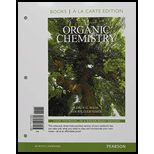
(a)
To determine: The expected product of the given
Interpretation: The expected product of the given
Concept introduction: Under normal conditions tertiary alcohols are not oxidized. However, when the tertiary alcohol is allylic, it undergoes a migration of the double bond (that is called an allylic shift) and subsequent oxidation of alcohol. Bobbitt’s reagent is helpful in such kind of oxidation reactions.
(b)
To determine: The expected product of the given
Interpretation: The expected product of the given
Concept introduction: Under normal conditions tertiary alcohols are not oxidized. However, when the tertiary alcohol is allylic, it undergoes a migration of the double bond (that is called an allylic shift) and subsequent oxidation of alcohol. Bobbitt’s reagent is helpful in such kind of oxidation reactions.
(c)
To determine: The expected product of the given
Interpretation: The expected product of the given
Concept introduction: Under normal conditions tertiary alcohols are not oxidized. However, when the tertiary alcohol is allylic, it undergoes a migration of the double bond (that is called an allylic shift) and subsequent oxidation of alcohol. Bobbitt’s reagent is helpful in such kind of oxidation reactions.
(d)
To determine: The expected product of the given
Interpretation: The expected product of the given
Concept introduction: Under normal conditions tertiary alcohols are not oxidized. However, when the tertiary alcohol is allylic, it undergoes a migration of the double bond (that is called an allylic shift) and subsequent oxidation of alcohol. Bobbitt’s reagent is helpful in such kind of oxidation reactions.
Want to see the full answer?
Check out a sample textbook solution
Chapter 11 Solutions
Organic Chemistry, Books a la Carte Edition (9th Edition)
- When anisole is treated with excess bromine, the reaction gives a product which shows two singlets in 1H NMR. Draw the product.arrow_forward(ii) Draw a reasonable mechanism for the following reaction: CI NaOH heat OH (hint: SNAr Reaction) :arrow_forwardDraw the major product in each of the following reaction:arrow_forward
- Draw the mechanism for the following Friedel-Craft reaction. AlBr3 Brarrow_forward(a) Draw the structures of A and B in the following reaction. (i) NaNH2, NH3(1) A + B (ii) H3O+arrow_forwardFor the reaction 2 N2O5(g) → 4 NO2(g) + O2(g), the following mechanism has been proposed: N2O5 →> NO₂+ NO3_(K1) NO2 + NO3 → N2O5 (k-1) NO2 + NO3 → → NO2 + O2 + NO (K2) NO + N2O5- NO2 + NO2 + NO2 (K3) d[N₂O5] __2k‚k₂[N2O5] Indicate whether the following rate expression is acceptable: dt k₁₁+ k₂arrow_forward
- Consider the following decomposition reaction of N2O5(g): For the reaction 2 N2O5(g) → 4 NO2(g) + O2(g), the following mechanism has been proposed: N2O5 → NO2 + NO3 (K1) NO2 + NO3 → N2O5 (k-1) NO2 + NO3 → NO2 + O2 + NO (K2) NO + N2O5 → NO2 + NO2 + NO2 (K3) Indicate whether the following rate expression is acceptable: d[N2O5] = -k₁[N₂O₂] + K¸₁[NO₂][NO3] - K¸[NO₂]³ dtarrow_forwardIn a reaction of A + B to give C, another compound other than A, B or C may appear in the kinetic equation.arrow_forwardFor the reaction 2 N2O5(g) → 4 NO2(g) + O2(g), the following mechanism has been proposed: N2O5 →> NO₂+ NO3_(K1) NO2 + NO3 → N2O5 (k-1) NO2 + NO3 → → NO2 + O2 + NO (K2) NO + N2O5- NO2 + NO2 + NO2 (K3) d[N₂O5] __2k‚k₂[N2O5] Indicate whether the following rate expression is acceptable: dt k₁₁+ k₂arrow_forward
- Given the reaction R + Q → P, indicate the rate law with respect to R, with respect to P and with respect to P.arrow_forwardSteps and explanations. Also provide, if possible, ways to adress this kind of problems in general.arrow_forwardk₁ Given the reaction A B, indicate k-1 d[A] (A). the rate law with respect to A: (B). the rate law with respect to B: d[B] dt dtarrow_forward
 Organic ChemistryChemistryISBN:9781305580350Author:William H. Brown, Brent L. Iverson, Eric Anslyn, Christopher S. FootePublisher:Cengage Learning
Organic ChemistryChemistryISBN:9781305580350Author:William H. Brown, Brent L. Iverson, Eric Anslyn, Christopher S. FootePublisher:Cengage Learning

